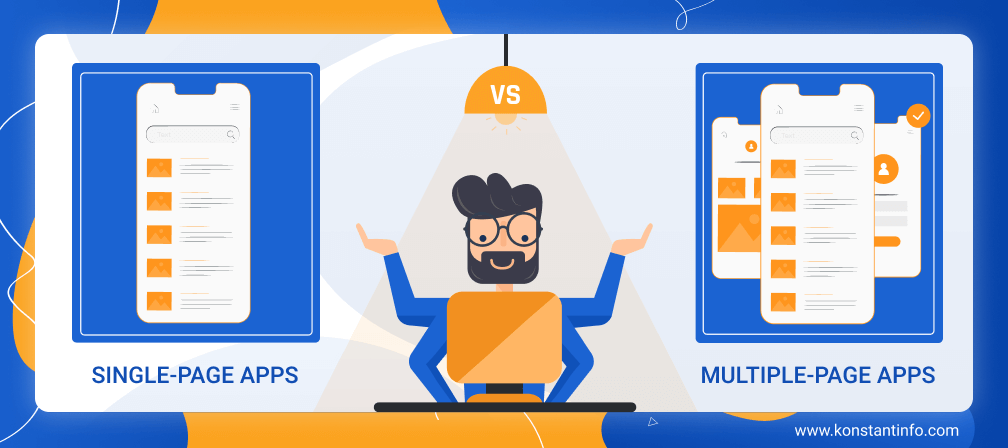
Web applications are convenient to code, easy to update and are not device-dependent. They bring in the requisite features of a mobile app and additionally they are replacing the browser-based web apps with the gradual increase in demand for feature enabled apps. Major three design patterns of web applications include – (1) Progressive Web Apps, (2) Single-Page Apps, and (3) Multi-Page Apps. As with every app type, single page and multi-page apps come with their set of pros and cons. Let’s discuss.
A single-page app fit into a single web page with dynamic actions without page refresh or reload (the webpage does not reload whenever we work with modules or multi-line textboxes or dropdowns or checkboxes or radio buttons) This characteristic improves performance by improving page load time, using AJAX to navigate across webpages etc.
Best examples of SPA’s are Gmail, Google Maps, Facebook, GitHub, Gmail, Google Maps, Airbnb, Netflix, Pinterest, Paypal.
A single page application is always a progressive web application, but the reverse is not always the case.
A single page application (SPA) is highly performant and it allows code reusability. But it is difficult to optimize it. Alternatively, multi-page applications (MPA) will help your business rank higher on Google Search Engine. MPA’s are not as performant as SPA’s.
Now, let’s understand the differences between Single-Page Apps and Multiple-Page Apps:
| Points of Difference | Single Page Applications | Multi-Page Applications |
|---|---|---|
| When to use? | SPA’s are suitable to build dynamic applications with small data volumes, particularly for SaaS platforms, closed communities and social media networks like Facebook, YouTube, Twitter, Jira, Netflix, Trello (CMS), Gmail, Google Docs etc (where SEO optimization is not required) | Multi-page applications serve across large organizations with an extensive range of categories, products, services portfolio and multiple inter-department operations like purchases, selling and reselling. e.g Amazon marketplace, Flipkart, Grofers, Walmart, Amazon, eBay etc. |
| What is it? | Single-Page Application (SPA) is a website design approach where each new page’s content is served without loading new. It enables dynamic rewriting of the current web page with new data from the web server, instead of the default method of loading new pages from the browser. | Multi-page apps are regular web apps where-in the entire webpage reloads each time we switch in between modules/dropdowns/radio buttons/checkboxes/text boxes. It can often be identified with the change in the URL each time when there is a data exchange back and forth, and a new page is requested from the server to display in the web browser. These allow creating new content and place it on new webpages. There is no page limitation whatsoever and as much information about the products and services can be accommodated. |
| Advantages | Benefits of Single Page Applications include:
| Benefits of Multi-Page Applications include:
|
| Disadvantages | SEO Is Not Easy: Single-page applications are dependent on JavaScript where data is to be requested from the server to be displayed on the client browser. It is difficult for the search bots to discover and scan such websites. SPA often face networking attacks like
|
|
| Use Cases | Social Media/Networking Apps | MPA’s can be used to create e-commerce apps, business apps, business catalogues and online marketplaces. |
| Page Loading | Single-page applications cache local storage effectively. An application has to send just one request, store all the data, use this data and work offline as usual. | The entire webpage reloads as a whole in case of any changes within the multiple page applications. Every time a new webpage request to the server and then displaying it to the client browser takes time and affects user experience. |
| Use of Frameworks | It is slow to download because heavy client frameworks are required to be loaded to the client. | The development across pages becomes quite complex without the use of Frameworks. |
| Functionality | Forward and Backward buttons become dysfunctional. | All buttons are functional. |
| Security | SPA’s are less secure. JavaScript memory leaks can loosen up the system. | MPA’s are more secure. Frontend and backend development are tightly coupled. Less menu navigation makes it efficient. |
| Size | Smaller – There is no client-server data exchange. | Larger than SPA’s. It makes use of AJAX to handle client-server data exchange. |
| Dependency on JavaScript | If a user disables JS in their browser, it won’t be possible to access Single Page Applications. | Multipage apps are not dependent on JS. However, JS can be used to improve the performance of the app in conjunction with CSS and HTML. |
| Architecture | In Single Page Application Architecture, the new page’s content is loaded by manipulating DOM elements on the existing web page. So there is no requirement to load a new HTML page every time. | In Multi-Page Application Architecture, each page sends a request to the server and updates every small chunk of data. Thus, the app performance is spent on displaying the same elements repeatedly, which is not the case with Single Page Applications. |
| How often are frameworks/technologies used? | Frameworks make SPA’s look more interactive and attractive. Single-Page Application Frameworks include React JS, Angular JS, Backbone, Ember JS, Node.js, Polymer JS, Vue JS, Aurelia, Mithril.js, Meteor JS, etc. | There are no preferences as such in multiple page application frameworks but still, Magento, WooCommerce, React and Angular JS frameworks can be used along with jQuery, HTML, CSS, JavaScript etc. React is considered an ideal framework for those who anticipate high traffic and need a stable platform to handle it. |
| Why is it preferred? |
|
|
Single Page Applications are high on performance, page rendering time and loading time is less. They allow code-reuse, convenient, cost-effective, navigable, easy to scan, well-formatted, good error handling, valid mark-up, clean code, contrasting colour scheme, usable formats. With all these details it becomes a valid choice to create a web app. But we still have multi-page applications that rank far better on search engines, include as many features/links/texts/images per webpage as required, are more secure than their single-page counterparts, are highly engaging and enable users to break down the content by allowing many entry points. Single Page web apps are suitable in case you target dynamic platforms with a very small amount of data to start with.
We discussed a lot about single-page apps so much when we already decided not to advocate a particular design approach (initially)! This is because any complex or fully-featured website or web app with multiple pages and lots of texts/images/links is being given the sideline. This shift in consumer perspective is because people look to engage with any interactive app, is high on performance, loads real quick, and provides every sort of convenience that a user looks for at first instance.
AJAX-enabled solutions are more preferable as these make it possible to render just a component of the application and not the entire page every single time. And if a single URL anchor as synthetic pages enabling is more inbuilt in browser navigation and preference functionality, with no back and forth buttons, slightly less featured but way more convenient and quick, why not go for it? We obviously can add one or more features as and when required to make it wholesome. Connect with us to know more about how to create a single page app (without using any framework) or about web app development in general.



Neeti Kotia is a technology journalist who seeks to analyze the advancements and developments in technology that affect our everyday lives. Her articles primarily focus upon the business, social, cultural, and entertainment side of the technology sector.
Or send us an email at: [email protected]